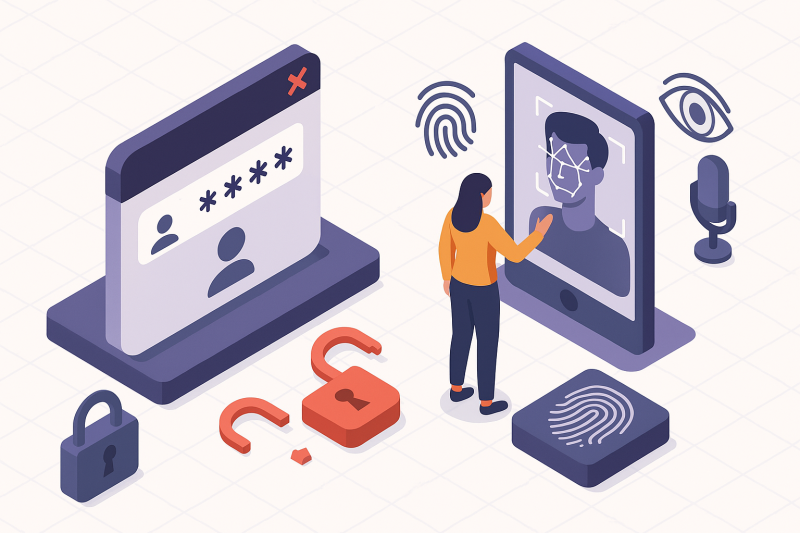Table of Contents Show
In the world of digital security, passwords have long been the default method of authentication. From logging into email accounts to securing online banking, passwords have historically stood as the first and often only barrier between users and hackers. But as our digital footprints expand and cyber threats evolve at an alarming pace, the cracks in this traditional form of security are becoming harder to ignore. We are now entering a new phase of authentication – welcome to the era of biometrics, where your body becomes the key.
The Inherent Flaws of Passwords
Passwords are easy to implement, but they were never designed to keep up with the modern threat landscape. The vulnerabilities associated with them are well documented, yet millions still rely on “123456” or “password” as their go-to credentials. Here’s why passwords are no longer sufficient:
1. Weak Password Creation
Most people opt for simplicity. A strong password with uppercase, lowercase, numbers, symbols, and 12+ characters is secure – but rarely used. Weak passwords are low-hanging fruit for brute-force algorithms and password-guessing bots.
2. Password Reuse Across Platforms
Using the same password for multiple accounts is a security disaster waiting to happen. A breach on one site can cascade across your digital life, granting hackers access to everything from your social media to your bank account.
3. Susceptibility to Phishing
Social engineering and phishing attacks are getting smarter. A legitimate-looking email or login page can trick even the savviest user into handing over their credentials.
4. Forgotten Password Hassles
Who hasn’t clicked “Forgot Password?” more times than they’d like to admit? The recovery process is a time sink and often involves secondary methods that can also be compromised.
5. Credential Stuffing and Data Breaches
Credential stuffing attacks exploit massive databases of stolen usernames and passwords. These breaches, often involving millions of users, make the whole password system appear outdated and broken.
What Are Biometrics?
Biometrics refer to the automated recognition of individuals based on their unique biological or behavioral traits. Unlike passwords, which can be forgotten, guessed, or stolen, biometric data is inherently tied to the individual and much harder to duplicate. Common biometric authentication methods include:
| Biometric Type | Description |
|---|---|
| Fingerprint Recognition | Scans and matches patterns of ridges on fingers |
| Facial Recognition | Uses the geometry of a person’s face for identification |
| Iris Scanning | Examines unique patterns in the colored part of the eye |
| Voice Recognition | Identifies speech patterns and vocal characteristics |
| Behavioral Biometrics | Tracks behavior patterns like typing rhythm or gait |
| Palm Vein Recognition | Uses infrared light to scan vein patterns in the hand |
Why Biometrics Are Taking Over
Biometric authentication is no longer just a sci-fi concept or luxury found on high-end devices. It’s rapidly becoming a standard, thanks to smartphones, border control systems, and secure workplace access. Here are key reasons why biometrics are surging:
1. Enhanced Security
Biometrics are incredibly difficult to fake. While hackers can steal passwords, duplicating a fingerprint or spoofing an iris scan is a lot harder. Plus, many biometric systems operate with encrypted templates rather than raw data.
2. User Convenience
No more password memorization. Biometric systems like Face ID and fingerprint scanning streamline the login process, improving user experience.
3. Reduced Risk of Phishing and Hacking
There’s no biometric equivalent of typing your password into a fake login page. This makes phishing attacks less effective.
4. Seamless Integration With Devices
Modern smartphones, laptops, and smart locks are all biometric-ready. This makes adoption frictionless for users.
5. Personalization and Continuous Authentication
Biometrics offer ongoing validation. Behavioral biometrics, for example, can detect anomalies in typing speed or mobile gestures and flag potential intrusions even after login.
Real-World Examples of Biometric Implementation
The shift to biometrics is already happening in both consumer and enterprise environments:
Apple and Face ID
Apple introduced Face ID in 2017 with the iPhone X, revolutionizing facial recognition for mainstream consumers. Face ID uses infrared and depth mapping to create a detailed facial map.
Airports and Border Security
Airports in the U.S., Europe, and Asia have implemented biometric systems to speed up immigration and boarding processes. For instance, Delta and JetBlue use facial recognition at boarding gates.
Banking and Financial Services
HSBC, JPMorgan Chase, and many other institutions now allow biometric login through mobile apps. Some banks in India even use Aadhaar-based biometric authentication for transactions.
Smart Homes and Cars
Biometric locks and ignition systems are replacing traditional keys. Cars like the 2023 Genesis GV60 offer fingerprint authentication for starting the engine.
Limitations and Ethical Concerns
Despite its many advantages, biometric authentication isn’t flawless.
Privacy Concerns
Biometric data is deeply personal. If compromised, unlike passwords, it cannot be changed. This raises significant privacy red flags. Unauthorized storage or misuse of biometric data can lead to intrusive surveillance.
Database Breaches
Although raw biometric data is often encrypted and stored as templates, breaches have occurred. In 2019, the BioStar 2 database leak exposed fingerprint and facial recognition data from over 1 million individuals TechCrunch.
False Acceptance and Rejection
No system is perfect. False positives may grant access to unauthorized users, while false negatives can lock out legitimate ones, especially in less-than-ideal conditions like poor lighting or injury.
Exclusion and Accessibility
Not everyone can provide biometric data. Individuals with disabilities, injuries, or certain medical conditions may find these systems unusable or unreliable.
Legal and Ethical Debates
Biometric surveillance used by governments and law enforcement raises serious civil liberty concerns. The debate is ongoing in regions like the EU and U.S. over how biometric data should be regulated Wired.
Multi-Factor Authentication (MFA) Gets a Biometric Boost
Multi-factor authentication has traditionally meant entering a password and receiving a one-time code via SMS or an authenticator app. Biometrics is now being added as a third layer.
MFA Components:
- Something You Know: Password or PIN
- Something You Have: A physical device or token
- Something You Are: A biometric trait
Using biometrics in MFA makes it exponentially harder for unauthorized users to break in, even if passwords are compromised.
Biometrics in the Workplace
Employers are embracing biometrics for more secure and efficient access control:
- Attendance Systems: Fingerprint or facial scans replace punch cards.
- Access Control: Biometric readers secure sensitive facilities.
- Remote Work Security: Biometric logins reduce risk in BYOD (Bring Your Own Device) environments.
However, implementation must be carefully managed. Companies need transparent policies, consent mechanisms, and robust data protection strategies.
Biometrics in Developing Countries
In countries with less robust ID infrastructures, biometrics are being used to build digital identities from the ground up.
India’s Aadhaar System
Aadhaar is the world’s largest biometric ID system, covering over 1.2 billion people. It uses fingerprints, iris scans, and facial data for everything from opening bank accounts to voting.
Nigeria’s National Identity Database
Nigeria has been rolling out biometric voter registration and national ID systems to streamline services and reduce fraud.
These systems improve inclusion but also raise concerns about surveillance and data misuse, especially in countries with weak privacy laws.
Future Innovations in Biometrics
The next generation of biometric technology will push boundaries even further:
1. Heartbeat Authentication
Each person has a unique ECG (electrocardiogram) pattern. Some wearables can already use this for user verification.
2. DNA-Based Security
Although still in the experimental stage, DNA could become the most secure and unique form of authentication.
3. Brainwave Biometrics
Using EEG (electroencephalogram) to measure brain activity could one day verify identity based on thought patterns.
4. Thermal Imaging
Facial recognition systems are being enhanced with thermal data to reduce spoofing and increase reliability in various lighting conditions.
5. Voice Biometrics in AI Assistants
Voiceprints are now being integrated into AI assistants like Alexa and Google Assistant for more personalized and secure interactions.
Philosophical Questions Around Biometric Identity
As we transition from something we know (passwords) to something we are (biometrics), philosophical questions arise:
- What happens when our body becomes a password?
- Do we retain ownership over our data, or are we handing parts of ourselves to corporations and governments?
- If biometric data is immutable, should its collection and use require more stringent consent?
These are not merely technical questions – they touch on ethics, autonomy, and the very definition of identity.
How to Protect Your Biometric Data
As consumers, we need to be proactive:
- Use Trusted Devices: Only share biometric data with secure, reputable platforms.
- Opt for On-Device Storage: Devices like Apple’s iPhone store biometric data locally, reducing exposure.
- Demand Transparency: Choose services that explain how they store, encrypt, and use your data.
- Update Regularly: Keep firmware and software updated to ensure you have the latest security patches.
- Use Biometrics as Part of MFA, Not the Only Line of Defense.
Regulatory Frameworks and Policy Developments
Governments are catching up with the tech:
- GDPR (EU): Treats biometric data as sensitive personal data, requiring strict processing rules.
- CCPA (California): Gives users the right to know what biometric data is collected and to opt out.
- Illinois BIPA: One of the strictest biometric laws, mandating written consent before collecting data.
Organizations that fail to comply with these frameworks face heavy fines and reputational damage.
Conclusion: The Hybrid Future
Passwords aren’t disappearing overnight, but their monopoly on authentication is undeniably over. The future lies in a layered approach that blends convenience, security, and user control. Biometrics, with all their promise and complexity, are central to this new landscape.
For now, the goal isn’t to replace passwords entirely but to supplement and eventually phase them out through smarter, safer, and more personalized systems. The next time you unlock your phone with your face or fingerprint, remember: you’re not just accessing your data. You’re living in the future of authentication.









